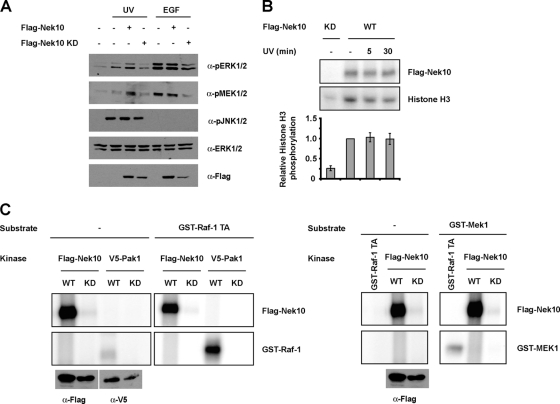FIG. 6.
Nek10 catalytic activity indirectly promotes UV-induced MEK1 activity. (A) Nek10 requires catalytic activity to enhance MEK1 catalytic activity. HEK293 cells were transfected with the indicated constructs. Cells were UV irradiated (250 J/m2) or stimulated with EGF (0.1 ng/ml) and harvested 30 min later. Lysates were immunoblotted as indicated. (B) Nek10 catalytic activity is not modulated by UV irradiation. HEK293 cells were transfected with the indicated constructs. Cells were lysed at the indicated times after UV irradiation (250 J/m2), and Nek10 was immunoprecipitated with M2 Flag agarose. Immunoprecipitates were subjected to an in vitro kinase assay with histone H3 as a substrate. (Top) Kinase assay mixtures were separated by SDS-PAGE and detected by autoradiography. (Bottom) The results from three independent experiments were quantified. Histone H3 phosphate incorporation was normalized against whole-cell levels of Flag-Nek10. Error bars represent standard errors of the means (SEM). (C) Nek10 does not phosphorylate Raf-1 or MEK1 in vitro. HEK293 cells were transfected with wild-type (WT) or kinase-dead (KD) Flag-Nek10 or V5-Pak1. Flag-Nek10 and V5-Pak1 immunoprecipitates or GST-Raf-1 TA (0.1 μg) were used in in vitro kinase assays with GST-Raf-1 TA (0.4 μg) (left) or GST-MEK1 (1.0 μg) (right) as a substrate. Kinase assay mixtures were separated by SDS-PAGE, and phosphorylation was detected by autoradiography.

